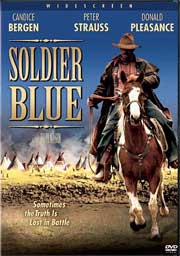 SOLDIER
BLUE (1970)
SOLDIER
BLUE (1970)Director: Ralph Nelson
Lionsgate Home Video
 SOLDIER
BLUE (1970)
SOLDIER
BLUE (1970) After the success of Sam
Peckinpah’s THE WILD BUNCH in 1969 and its ground breaking approach to
violence, for a major studio particularly, it immediately opened the doors for
other film makers to push the envelope to greater heights, and also sparked
a renewed interest in Westerns in the U.S. (for a short time). One of the first,
and most controversial, to hop on both band wagons was SOLDIER BLUE. Although
not a WILD BUNCH rip-off by any means, it was obviously influenced by its ground
breaking violence (and I’m sure the Vietnam War). But SOLDIER BLUE far
outgrossed Peckinpah’s film as far as graphic bloodshed was concerned.
In fact few filmmakers since have dared to put graphic child killings on screen.
SOLDIER BLUE tells the story of a cavalry postal group of soldiers escorting a basically mail order bride (Candice Bergen) to her husband who is a U.S. Cavalry Soldier. But she was once a bride to a Cheyenne Chief and he wants her back. The Calvary gets ambushed by the Cheyennes and get slaughtered with only Cresta (Bergen) and a young soldier, Homos Grant (Peter Strauss), surviving. Homos is sickened and horrified to see his friends all dead and butchered, but Cresta tells him who the real savages are as it was the white man who first practiced the art of scalping and many other atrocities attributed to Indians. They must find their way to the Army camp where Cresta’s husband awaits, but along the way they run into a sleazy gun salesman (Donald Pleasance) who is trading rifles to the Cheyennes. Upon reaching their destination, they learn that the troops are planning a bloody revenge on the Cheyennes’ village.
 I
have often wondered if Marlon Brando ever saw this film, especially in its full
strength version. He always wanted to do a film about how Indians were mistreated
by the white man and disprove the myths of the cowboy and Indian wars of the
old Hollywood movies and legends. SOLDIER BLUE was released to considerable
controversy but little box office appeal, at least in the U.S. Perhaps word
of mouth about the still shocking ending put viewers off. Seeing adults suffer
bloody deaths on screen is one thing, but innocent children is another.
I
have often wondered if Marlon Brando ever saw this film, especially in its full
strength version. He always wanted to do a film about how Indians were mistreated
by the white man and disprove the myths of the cowboy and Indian wars of the
old Hollywood movies and legends. SOLDIER BLUE was released to considerable
controversy but little box office appeal, at least in the U.S. Perhaps word
of mouth about the still shocking ending put viewers off. Seeing adults suffer
bloody deaths on screen is one thing, but innocent children is another. 
Until recently, SOLDIER BLUE has been difficult to see in its original uncut version. The only one that I was aware of and actually got to see was a damn rare British pre-CERT video from way, way back. But it was far from perfect as video technology at the time was primitive plus take into PAL to NTSC conversion and poor pan and scanning (it was a Panavision film), it was quite a mess as colors were off and picture was not too sharp and badly zoomed in. SOLDIER BLUE was cut to get an “R” rating in the U.S., then cut further to get a “PG” in an effort to get more box office. When released on VHS by Embassy, it was the “R” print on a “PG” package, with a shortened running time under its re-release year (1974) on the box cover. Now you don't need an all region DVD player to see it as Lionsgate has released this out fully uncut and in its original 2:35:1 ratio and 16x9 enhanced. Note: some sites like Deep Discount DVD are falsely advertising it as 1:33 -- don’t worry, it is widescreen! And a nice picture it is. Nothing to complain about until the very end when the narration is on during the empty Cheyenne village scene, which leads into the end credits, there is some dirt and mild scratches.
 Now
the bad news for fans of this film and this wont be a shock I am sure—it
is an all but bare bones release. Menu and chapter stops and language subtitle
options, English and Spanish, and that is it. Not even the trailer! Maybe one
day Anchor Bay or Blue Underground will get this. But the important thing is
it looks great and is uncut, speaking of which, it carries the “R”
rating at the beginning of the film. I would be interested to know if the movie
was recently re-released, or if Lionsgate even knew what they had if they went
back to the original camera negative, and if it was resubmitted to the MPAA
(sometimes, like in the U.K., if a film is historical they are more lenient).
Like it or not it has a still powerful climax that first time viewers won’t
soon forget. (Allan Cope)
Now
the bad news for fans of this film and this wont be a shock I am sure—it
is an all but bare bones release. Menu and chapter stops and language subtitle
options, English and Spanish, and that is it. Not even the trailer! Maybe one
day Anchor Bay or Blue Underground will get this. But the important thing is
it looks great and is uncut, speaking of which, it carries the “R”
rating at the beginning of the film. I would be interested to know if the movie
was recently re-released, or if Lionsgate even knew what they had if they went
back to the original camera negative, and if it was resubmitted to the MPAA
(sometimes, like in the U.K., if a film is historical they are more lenient).
Like it or not it has a still powerful climax that first time viewers won’t
soon forget. (Allan Cope)